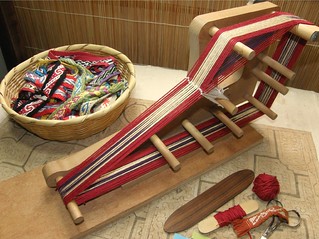
|
Andean Pebble Weave on Inkle Looms by Laverne WaddingtonThis book on Andean Pebble Weave is aimed specifically at weavers who use inkle looms and particularly at those who are beginners in pick-up weaving! Although there are unlimited possibilities for weaving beautiful bands in plain weave on inkle looms, perhaps you are now ready to add some motifs to your bands….geometric patterns and little animal figures sitting on an attractive pebbly background. With the experience of warping your inkle loom and weaving plain-weave bands behind you, you can now venture into the world of pick-up patterns with methods that have been designed specifically for your kind of loom and your level of experience. The Andean Pebble Weave structure with its characteristic spotted background, is woven in the highlands and lowlands of Bolivia on looms that bear no resemblance to an inkle loom. Highland weavers have at least one end of the warp attached to their bodies. In lowland Bolivia, vertical frames are used as looms. The author has seen and studied these lovely patterns being produced using four distinctly different methods and she brings aspects of each of these to the methods she presents, taking into account the particular characteristics of the simple, yet versatile, inkle loom. |
|
Sample Pages:
Laverne has adapted methods for use on what she calls the “standard” inkle loom.....a frame with pegs that allows adjustments to warp-tension. Individual string heddles hold one layer of threads in place while the weaver raises or lowers the other layer to create the two basic sheds. Laverne uses and teaches the methods on her Ashford Inklette while her friends Bradie and Ruth contribute with their Schacht and full-size Ashford looms.

Three different methods for creating Andean Pebble Weave patterns are presented, two of which are aimed at beginner pick-up weavers. The third method is one which beginners can try, if they like, when they have gained a little experience and are interested in adding some short-cuts to perhaps speed-up the process. All three methods produce the same pretty results! You can decide which method best suits your weaving style.
There is a method for those who enjoy getting their fingers in among the threads. The only tools that are required are those that you would normally use to produce plain weave…something with which to beat and carry the weft. Another uses a few additional tools which are as simple as two pencils and a pointed stick. The third requires some additional materials to set-up the warp, no additional tools for weaving, and is for those who are interested in making a little extra effort in order to see the patterns appear on their bands faster.
In order to cater to as many learning styles as possible, the instructions are presented in various forms. Dozens of step-by-step pictures are used. Detailed text accompanies each and every picture. Instructional video clips take you through the steps all over again and there is an additional set of video clips called “Just Weaving” where you can watch the flow of each of the three methods, uninterrupted by instruction.
Tutorials cover how to recognize mistakes and un-weave, finish a band, lay out patterns and manage chart-reading. Tips for left-handed weavers are provided. The book finishes with twenty-two Andean Pebble Weave pattern charts for small motifs which are perfectly suited to beginner-level. Plus, there are two surprise bonus charts with patterns that you will love!
(If you already own and are using Laverne’s Complementary-warp Pick-up book, which covers a method that can be used on a much broader range of looms, you won’t need this new book dedicated to inkle looms....unless you are curious about adding more methods for doing pick-up on inkle looms to your repertoire!)
| Average rating: | (based on 16 ratings) |
